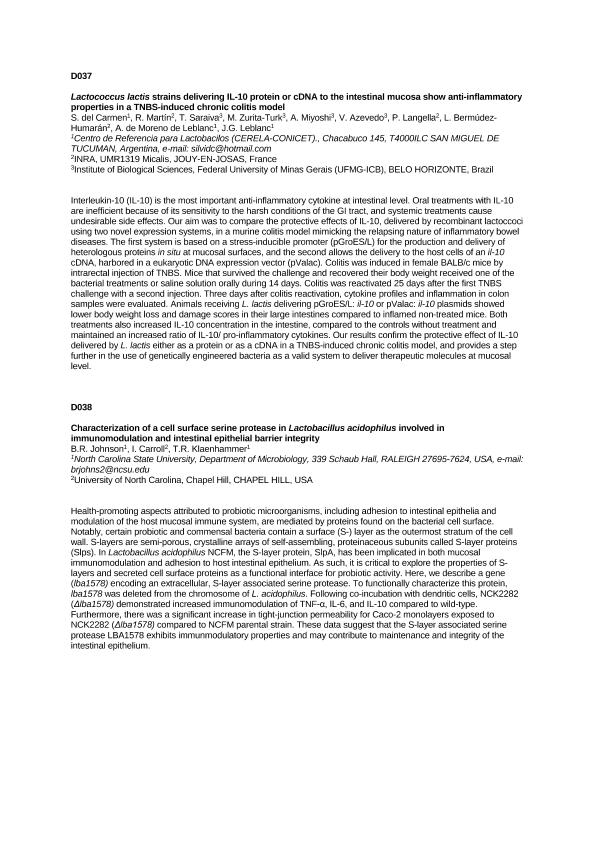Evento
Lactococcus lactis strains delivering IL-10 protein or cDNA to the intestinal mucosa show anti-inflammatory properties in a TNBS-induced chronic colitis model
del Carmen, Silvina Andrea ; Martín, Rebeca; Saraiva, Tessalia; Zurita Turk, Meritxell; Miyoshi, Anderson; Azevedo, Vasco; Langella, Philippe; Bermúdez Humarán, Luis G.; de Moreno, Maria Alejandra
; Martín, Rebeca; Saraiva, Tessalia; Zurita Turk, Meritxell; Miyoshi, Anderson; Azevedo, Vasco; Langella, Philippe; Bermúdez Humarán, Luis G.; de Moreno, Maria Alejandra ; Leblanc, Jean Guy Joseph
; Leblanc, Jean Guy Joseph
 ; Martín, Rebeca; Saraiva, Tessalia; Zurita Turk, Meritxell; Miyoshi, Anderson; Azevedo, Vasco; Langella, Philippe; Bermúdez Humarán, Luis G.; de Moreno, Maria Alejandra
; Martín, Rebeca; Saraiva, Tessalia; Zurita Turk, Meritxell; Miyoshi, Anderson; Azevedo, Vasco; Langella, Philippe; Bermúdez Humarán, Luis G.; de Moreno, Maria Alejandra ; Leblanc, Jean Guy Joseph
; Leblanc, Jean Guy Joseph
Tipo del evento:
Simposio
Nombre del evento:
11th International Symposium on Lactic Acid Bacteria: Health, sustainability, diversity, and application
Fecha del evento:
31/08/2014
Institución Organizadora:
Federation of European Microbiological Societies;
Royal Netherlands Society for Microbiology;
Título del Libro:
11th International Symposium on Lactic Acid Bacteria. Health, sustainability, diversity, and application: Book of abstracts
Editorial:
Federation of European Microbiological Societies; Royal Netherlands Society for Microbiology
Idioma:
Inglés
Clasificación temática:
Resumen
Interleukin-10 (IL-10) is the most important anti-inflammatory cytokine at intestinal level. Oral treatments with IL-10 are inefficient because of its sensitivity to the harsh conditions of the GI tract, and systemic treatments cause undesirable side effects. Our aim was to compare the protective effects of IL-10, delivered by recombinant lactoccoci using two novel expression systems, in a murine colitis model mimicking the relapsing nature of inflammatory bowel diseases. The first system is based on a stress-inducible promoter (pGroES/L) for the production and delivery of heterologous proteins in situ at mucosal surfaces, and the second allows the delivery to the host cells of an il-10 cDNA, harbored in a eukaryotic DNA expression vector (pValac). Colitis was induced in female BALB/c mice by intrarectal injection of TNBS. Mice that survived the challenge and recovered their body weight received one of the bacterial treatments or saline solution orally during 14 days. Colitis was reactivated 25 days after the first TNBS challenge with a second injection. Three days after colitis reactivation, cytokine profiles and inflammation in colon samples were evaluated. Animals receiving L. lactis delivering pGroES/L: il-10 or pValac: il-10 plasmids showed lower body weight loss and damage scores in their large intestines compared to inflamed non-treated mice. Both treatments also increased IL-10 concentration in the intestine, compared to the controls without treatment and maintained an increased ratio of IL-10/ pro-inflammatory cytokines. Our results confirm the protective effect of IL-10 delivered by L. lactis either as a protein or as a cDNA in a TNBS-induced chronic colitis model, and provides a step further in the use of genetically engineered bacteria as a valid system to deliver therapeutic molecules at mucosal level.
Palabras clave:
INTERLEUKIN-10
,
INFLAMMATORY BOWEL DISEASES
,
CDNA
,
COLITIS
Archivos asociados
Licencia
Identificadores
Colecciones
Eventos(CERELA)
Eventos de CENTRO DE REFERENCIA PARA LACTOBACILOS (I)
Eventos de CENTRO DE REFERENCIA PARA LACTOBACILOS (I)
Citación
Lactococcus lactis strains delivering IL-10 protein or cDNA to the intestinal mucosa show anti-inflammatory properties in a TNBS-induced chronic colitis model; 11th International Symposium on Lactic Acid Bacteria: Health, sustainability, diversity, and application; Egmond aan Zee; Países Bajos; 2014; 116-116
Compartir



